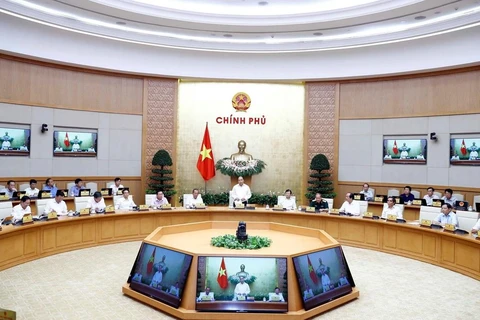Hanoi (VNA) – The Asian Development Bank (ADB) has forecast that Vietnam’s economy will maintain healthy growth in 2019 and 2020 at 6.8 percent and 6.7 percent, respectively, after the exceptionally high expansion of 7.1 percent last year.
Despite a slowdown in exports, the economy remains broadly healthy thanks to resilient domestic demand and sustained inflows of foreign direct investment (FDI), according to the bank’s Asian Development Outlook 2019 Update released in Hanoi on September 25.
“Despite a slowdown in export growth due to the escalation of the trade conflict between the United States and the People’s Republic of China and the consequent downturn in global trade, the Vietnamese economy remains healthy thanks to continued strength in domestic demand and sustained inflows of foreign direct investment,” said ADB Country Director for Vietnam Eric Sidgwick.
“Prospect for domestic consumption continues to be positive, supported by rising incomes, buoyant employment and moderate inflation,” he said.
Forecasts for average inflation have been revised down to 3 percent from 3.5 percent for 2019, and to 3.5 percent from 3.8 percent for 2020.
Vietnam’s GDP grew 6.8 percent in the first half this year, slightly down from 7 percent in the corresponding period of last year. Exports of goods and services slowed by more than half, from 15.7 percent in the first six months of 2018 to 7.1 percent the same period this year, due to weakened external demand.
However, the adverse effect of the export slowdown on GDP growth was well cushioned by continued strength in domestic demand, the report said. Private consumption expanded 7.2 percent in the first half this year, the same rate as a year earlier. Meanwhile, domestic investment grew 7.1 percent, bolstered by an improved business environment, strengthened investor confidence and strong FDI inflows.
FDI disbursement is estimated to have risen by 8.1 percent in the first half of 2019 to reach 9.1 billion USD, equal to 8.4 percent of GDP. Reflecting improved business sentiment, foreign equity investment nearly doubled in the first six months over the corresponding period in 2018, hitting 8.1 billion USD.
In the first half, all sectors witnessed slower growth but agriculture fell the hardest.
Prolonged drought and African swine fever outbreak dragged growth in agriculture down from 3.8 percent year-on-year to 2.4 percent in the first six months. Within agriculture, growth in farm production dropped sharply from 3.1 percent to 1.3 percent, and forestry output growth eased from 5.5 percent to 4.2 percent, while fisheries sustained a strong 6.4 percent expansion.
The report also upheld continued government efforts to improve the business environment, along with recent upward revisions to sovereign credit ratings, would spur both private and foreign investment.
If the US-China trade conflict continued to escalate, more manufacturers may consider Vietnam as an alternative base, providing fresh impetus for FDI inflows, it said.
Additionally, the regional Comprehensive and Progressive Agreement for Trans-Pacific Partnership (CPTPP) and the recent signing of the free trade agreement with the European Union promised to further open market access for trade and investment.
FDI inflows should therefore continue to be strong in the near term, as evidenced by 13.1 billion USD in FDI commitments in the first eight months, it said.
Recent amendments to the Public Investment Law should improve public investment by accelerating processes, simplifying procedures and enabling faster disbursement of public investment.
While retaining the growth outlook for Vietnam for this year and the next, the report also highlighted significant risks to the forecast. Further escalation of the US-China trade tension and continuing global economic slowdown could shrink global trade, adversely impacting the country’s trade performance and economic growth.
By sector, the outlook for industry and services remained positive, but agriculture will likely continue to be sluggish, according to the report.
The manufacturing purchasing managers’ index remained above 50 in the first eight months, which bodes well for the industry. Services are seen to continue growing with further expansion in retail and wholesale trade to meet buoyant demand and higher tourist arrivals, assuming they reach the target of 15 million by year-end./.

ADB upgrades growth forecasts for Southeast Asia
The Southeast Asian region is likely to record an economic growth rate of 4.8 percent this year and 4.9 percent in 2020, according to the Asian Development Bank (ADB).






















